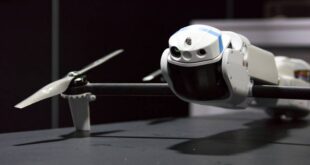When the US Air Force launched the F-16 Fighting Falcon in 1979, it had something no other military jet did: a computer. Four, actually. Their electrical signals commanded the aircraft instead of gears and pulleys, ushering aerial combat into the digital era. Now, after fighting in the Gulf and Iraq wars, some of these 49-foot supersonic jets are speeding toward an autonomous future. Believe it or not—we don’t blame you for thinking the buttons in this cockpit couldn’t belong to a droid—they’ve been retooled and given (short) new lives as drones.
Colonel Steven Boatright, commander of the Weapons Evaluation Group at Tyndall Air Force Base in Florida, who’s flown Falcons for 25 years, says F-16s are perfect for dronification, because their computer systems make them easy to modify. The Air Force began converting the craft into QF-16s (the Q designating drones) in 2010. This year, up to 32 will fly over the Gulf of Mexico as elusive moving targets until they’re sacrificed to missiles and guided bombs, helping Boatright’s unit figure out how those missiles and bombs the government wants to buy actually work in stress tests.
To get these jets into flying, and dying, shape, Air Force engineers resurrect old F-16s from a 2,600-acre boneyard in Arizona. Then Boeing rigs them with $1.9 million in Drone Peculiar Equipment, including an automatic flight system that triggers takeoffs and landings at the press of a button. Soon they’re condemned to Tyndall’s “death row” runway. They perform elaborate maneuvers (barrel rolls, S turns), mimicking what enemies might do in battle, until they’re shot down and sink to the bottom of the ocean, the wreckage reincarnated as a reeflike hangout for sharks and barracudas. (Ground control can also blow up any erratic drone by remotely detonating the plane’s AIM-9 warhead.) The boneyard has enough F-16s to keep Boatright busy for the next decade, and maybe even fuel a robot war. In March, Air Force assistant secretary Will Roper cited QF-16s as a potential host for a machine learning program called Skyborg. That AI aims to turn drones into wingmen capable of fighting and hurling bombs alongside humans piloting the most advanced stealth aircraft by 2023.
LAURA MALLONEE (@LauraMallonee) writes about photography for WIRED.
This article appears in the December issue. Subscribe now.
More Great WIRED Stories
 Unmanned Aerial Vehicle The latest drone news
Unmanned Aerial Vehicle The latest drone news


